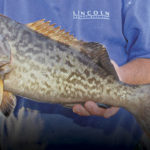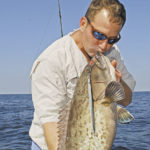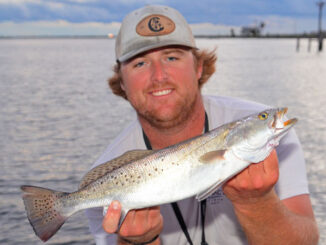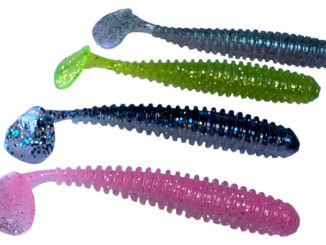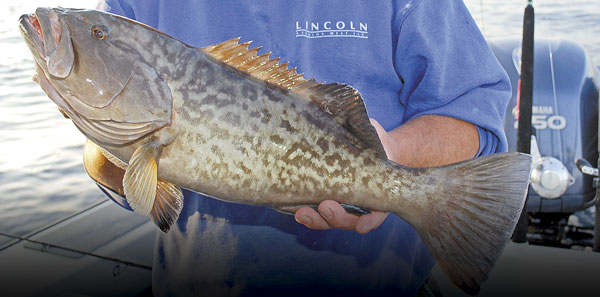
Sometimes fish names make no sense whatsoever. Take for example, gag. Excuse my language ahead of time, but that’s a helluva name for such a wonderful fish. They didn’t even dignify it by adding the word “grouper” after it, but a grouper it is. It, and its kissing cousin, the scamp, are the two most common grouper species caught by Louisiana sportsmen. Unfortunately, gag may only be kept during a short season each year.
The origin of their scientific name, Mycteroperca microlepis, is easier to decipher than is their common name. Derived all from Greek, rather than Latin, it means small-scaled nose-perch.
Gag are most identifiable by their lack of distinguishing features. Their body color is an overall mottled gray. The dark mottlings are often arranged in “kiss-shaped” patterns. These somewhat resemble the dark box-shaped patterns found on the true black grouper, for which they are occasionally mistaken. Black groupers are relatively rare in the northern Gulf of Mexico, being much more common in southern Florida waters.
Black groupers grow larger than gags, often reaching 50 pounds and occasionally as large as 180 pounds. Besides being lighter in color than black grouper, gags have a slightly different tail shape. The back edge of a black grouper’s tail is squared off, and a gag’s is slightly concave.
Male gags over 32 inches long may develop a dark, rusty-colored, wide strip on their undersides, and are often referred to as “copperbellies.”
Gags, like most if not all other grouper species, are protogynous hermaphrodites.
Protogynous means “female first,” and true to the description, all gags are hatched as females. After hatching, the tiny baby groupers are carried into nearshore and inshore waters by currents. Many spend their first summer on oyster reefs, feeding on small shrimp and other creatures. When seen by anglers, few recognize them as small groupers, not associating groupers with inshore waters.
At about 4 months of age and 5 inches long, they switch to a fish diet, which is their preferred food for the rest of their lives. By the end of the fall, they average 12 inches long and all are still females. At this size, they migrate offshore, where they stake out a territory that they seldom leave until they are large enough to spawn.
Gag groupers grow rapidly until they are 10 years old and an average size of over 40 inches. After that, growth rates slow dramatically. By 29 inches long, half of all fish are sexually mature and can spawn. Gags under 32 inches and 5 years old are still all females. By age 6, all of them are mature. After that, the largest fish begin to change gender to males, typically after spawning. By 42 inches long and 11 years of age, the sex ratio is about even. At progressively larger sizes, the percentage of males increases.
The biology of the creature has been cause for some concern amongst biologists. Larger groupers are the most aggressive and are the first to take any bait offered. The result is that they are the first fish removed from the population, and in some areas not enough males may be present to fertilize the available mature females.
In the south Atlantic, a study showed that the percentage of males in the population fell from 33.3 percent of the population in 1976 to 3.7 percent in 1996. Reseach in the Gulf of Mexico has yielded similar numbers.
Adult gags are found in waters 60 to 250 feet deep and occasionally to over 500 feet deep. They show a strong attraction to some sort of bottom relief, such as rocks, reefs, shipwrecks and offshore oil and gas platforms. Research done off Florida showed that the average size of gag groupers increased with increasing water depth. The researchers were unsure as to whether this was a natural occurrence or due to more fishing pressure occurring in shallower waters.
What is known is that gags will move substantial distances alone or in small groups from their territories for group spawnings, called aggregations. Spawning typically takes place from December to May, with peaks on the full moons of February, March and April. Gags feed actively while in spawning aggregations, and can be targeted by fishermen, here again removing the largest and most aggressive males.
A tagging study done between 1995 and 1999 showed that while 36 percent of the gags tagged moved 1 mile or less from where tagged to where recovered, another 23 percent moved 110 miles or more before recapture. The long distance champ was a fish tagged off South Carolina that moved 1,060 miles into the Gulf of Mexico. Gags tagged in shallow water showed more movement than those tagged in deep water.
Gags are highly piscivorous, meaning that they like to eat fish rather than crustaceans and other creatures. Finfish make up 95 to 98 percent of their diet. Especially heavily consumed are Spanish sardines, pinfish, mullet and round scad. Porgies and jacks are also commonly eaten. Crabs are the most common invertebrates in their diet.
